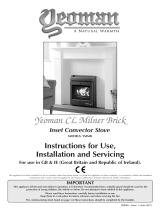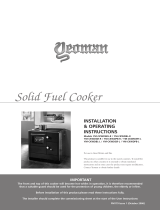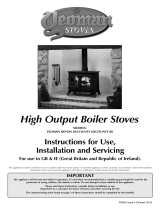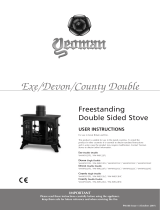
OPERATING INSTRUCTIONS
14
3
.11 We would recommend that the stove be burnt at high
o
utput for at least 30 minutes each day when it is in use.
This will help reduce the build-up of tars and creosotes
within the stove and flue system.
3
.14 Do not burn painted or impregnated wood,
m
anufactured board products, pallet wood or scrap
timber.
4. BURNING SOLID FUEL
4.1 Open the Airwash control to approximately 50% and
Primary air control fully.
4.2 Place some pieces of firelighter or dry crumpled paper on
the grate and cover with some small pieces of dry
kindling wood. Light the paper or firelighters.
4.3 To avoid the build-up of condensation on the door glass
it is advisable to leave the door slightly open as the fire
establishes and the glass warms.
4.4 As the fire becomes established add pieces of solid fuel
and fully close the door.
Do not leave the stove with the
door open as this could over-fire the stove and cause
permanent damage.
4.5 As the fire becomes established, reduce the Airwash air
control
to approximately 25% and control the burn rate
using the
Primary air control only.
4.6 To burn solid fuel efficiently it is best to control the
combustion using the
Primary air control only.
4.7 Before re-fuelling the stove it is advisable to first de-ash
the firebed, using the riddling grate system (if fitted) or a
suitable poker.
Do not use bare hands to operate the
riddling system or if using a poker to clear the firebed.
4.8 Then open the Primary air control fully for a few
minutes, to establish a glowing bed before adding new
fuel. Allow the new fuel to burn at high output for a few
minutes before adjusting the burn rate with the
Primary
air control
to the desired setting. It is best to refuel little
and often to maintain clean and efficient burning.
4.9 The ideal control settings to suit the particular
installation and personal preferences will be established
by experience in using the stove.
4.10 We would recommend that the stove be burnt at high
output for at least 30 minutes each day when it is in use.
This will help reduce the build-up of tars and creosotes
within the stove and flue system.
4.11 Do not burn bituminous coal, ‘petro
-
cok
e’ or other
petroleum based fuels, as this will invalidate the
product guarantee.
O
VER-FIRING
4.12 Do not use the appliance at maximum output for
prolonged periods of time, or over fill the firebox with
f
uel, as this could result in over-firing. If the connecting
f
luepipe, appliance flue collar or top plate glow red with
h
eat the appliance is being over-fired and the air controls
should be closed to reduce the output.
4.13 If a chimney fire occurs shut all air controls immediately
to close the appliance down, and evacuate all persons
from the building before calling the fire brigade. Do not
re-enter the building until it is confirmed safe to do so.
4.14 Following a chimney fire do not use the appliance until it
is inspected, by a HETAS (GB only) registered installer,
to confirm that the appliance is safe to use, or make any
repairs required before re-use. Only genuine Stovax
replacement parts are to be used to keep your appliance
in safe and efficient working order
.
4.15 After any chimney fire it is recommended that the
chimney system be inspected and swept by a NACS
registered (UK only) chimney sweep, to confirm that the
system is structurally sound and free from any
obstructions before re-use.
SEASONAL USE
4.16 If the stove is not to be used during the warmer periods
of the year it is recommended to clean and service the
stove, as detailed in the maintenance and servicing
section of this booklet.
4.17 The air controls should be set in the 50% open position
to keep the appliance ventilated, and stop the build-up of
any moisture inside.
4.18 Before re-lighting the stove remove the baffles, clear any
debris that may have accumulated, and check the flue is
clear of any block
ages.
5. ASH REMOVAL
5.1 The burning of any fuel will produce ash, which will have
to be removed after a period of use. This time will depend
on the fuel used. Before removing the ash from the stove
it is advisable to let the fire burn down to a low level, or
even go out completely
. The ashpan can be removed
from the stove after opening the door
.
5.2
As heat can remain in the ash for a long period after use
care must be tak
en when removing and carrying the full
ashpan. We suggest that the ashpan be carried using
gloved hands, or the ash is placed directly into a Stovax
Ash Caddie.

























